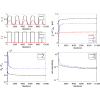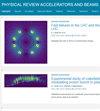New method to measure the unloaded quality factor of superconducting cavities
IF 1.8
3区 物理与天体物理
Q3 PHYSICS, NUCLEAR
Physical Review Accelerators and Beams
Pub Date : 2024-03-21
DOI:10.1103/physrevaccelbeams.27.032001
引用次数: 0
Abstract
We describe a method that measures the unloaded quality factor , the external quality factor , and the cavity detuning with a recursive least-squares algorithm. It combines a large number of consecutive measurements to successively improve an estimate of fit parameters that asymptotically converges to the “real” values. Exploiting the large amount of data acquired by a digital low-level radio frequency system permits us to reach this asymptotic regime in a moderate time frame of seconds to minutes. Simulations show that the method works both for critically coupled and overcoupled cavities. A new calibration method addresses very tight tolerances of the method on system parameters.

测量超导空腔空载品质因数的新方法
我们介绍了一种用递归最小二乘算法测量空载品质因数 Q0、外部品质因数 QE 和腔体失谐 Δω 的方法。该算法结合大量连续测量结果,连续改进拟合参数的估计值,使其渐近收敛到 "真实 "值。利用数字低频射频系统获取的大量数据,我们可以在几秒到几分钟的中等时间内达到这一渐近机制。模拟结果表明,该方法适用于临界耦合和过耦合腔体。一种新的校准方法解决了该方法对系统参数的极小公差问题。
本文章由计算机程序翻译,如有差异,请以英文原文为准。
求助全文
约1分钟内获得全文
求助全文
来源期刊

Physical Review Accelerators and Beams
Physics and Astronomy-Surfaces and Interfaces
CiteScore
3.90
自引率
23.50%
发文量
158
审稿时长
23 weeks
期刊介绍:
Physical Review Special Topics - Accelerators and Beams (PRST-AB) is a peer-reviewed, purely electronic journal, distributed without charge to readers and funded by sponsors from national and international laboratories and other partners. The articles are published by the American Physical Society under the terms of the Creative Commons Attribution 3.0 License.
It covers the full range of accelerator science and technology; subsystem and component technologies; beam dynamics; accelerator applications; and design, operation, and improvement of accelerators used in science and industry. This includes accelerators for high-energy and nuclear physics, synchrotron-radiation production, spallation neutron sources, medical therapy, and intense-beam applications.
 求助内容:
求助内容: 应助结果提醒方式:
应助结果提醒方式:


